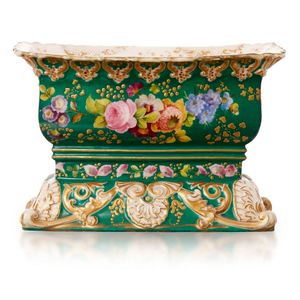Grainger's Worcester Wall Plaque with Royal Crescent View
You must be a subscriber, and be logged in to view price and dealer details.
Subscribe Now to view actual auction price for this item
When you subscribe, you have the option of setting the currency in which to display prices to $Au, $US, $NZ or Stg.
- Emeralds - Emeralds have been used in jewellery making for thousands of years, and are prized for their deep green colour, which is caused by the presence of chromium and vanadium in the mineral beryl. Because of their rare colour, emeralds are often more valuable than diamonds of a similar size and quality. In jewellery making, emeralds are typically cut into round or oval shapes to maximize their color and clarity. They are often set in gold or platinum and used as the centrepiece of a piece of jewellery, such as a ring or necklace. They can also be used in combination with other gems, such as diamonds, to create intricate and beautiful designs.
- Verso - Verso is the "back" side of a sheet of paper, art work, coin or medal. The front side is "recto".
- Acanthus - A stylized leaf motif, one of the primary decorative elements of classical Greek and Roman architecture, derived from the genus of flowering plants in the family Acanthaceae, native to tropical and subtropical regions of the Mediterranean area. It is a common element in classical Greek and Roman design, and is often seen in Corinthian and Composite order columns and used as a decorative element in English, European and Australian furniture, particularly on the curve of a leg, and as decoration for a corbel.
- Circa - A Latin term meaning 'about', often used in the antique trade to give an approximate date for the piece, usually considered to be five years on either side of the circa year. Thus, circa 1900 means the piece was made about 1900, probably between 1895 and 1905. The expression is sometimes abbreviated to c.1900.
This item has been included into following indexes:
- plaques - ceramic, various makers 369
- Royal Worcester (England), item types
Visually similar items

English hallmarked sterling silver engraved card case central monogram Mw Birmingham, 1841, maker George Randle weight 54g

A Napoleon III porcelain and gilt enamel jardiniere, by Jacob Petit, circa 1840, profusely painted with flowers and tolled gilt on a green ground. J.P mark to base, 15 cm long

A fine Berlin KPM portrait plaque of Princess Louise, circa 1840, an exquisite portrait of the Princess descending a staircase in full court dress with a gold embroidered gown and ermine dressed trimmed cloak, impressed mark of KPM and sceptre mark to reve

German lacework porcelain figure group Romantic Duo, 38 cm wide, 26 cm high
